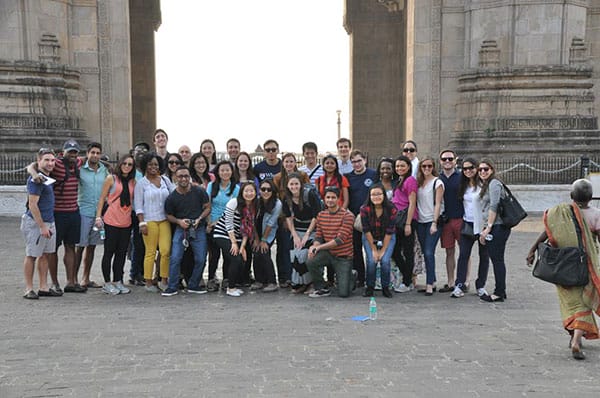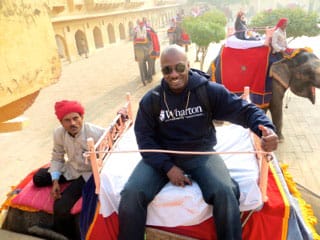I was drawn to the Wharton Global Immersion Program (GIP) as my first major trip at Wharton largely due to the fact that I am a huge history geek and am keener to explore the site of an ancient palace and learn about its significance in the world than to visit a beach. The GIP trips combine an on-the-ground education in the economic, cultural and geopolitical particulars of an emerging region of the world with vacationing and relationship-building.

Wharton India GIP 2013-14
A cohort of about 30 Wharton students made the trip to India. At the risk of sounding cliché, I could not have chosen a more fun, interesting and diverse group of travel companions, and cadre of native Indian coordinators and guides, to share this experience with. And while I could quite literally go on for hours about this experience, I will cover just a few of its most interesting highlights here:
Mumbai
One observation that I found interesting about this amazing country during our first of many cab rides was seeing the peaceful coexistence of the old and new worlds, such as a cow crossing a street two blocks from a 50-floor skyscraper. In no part of India that I visited was this contrast more glaring than in Mumbai.
While there, we visited Pratham Education Foundation, the largest NGO working to ensure quality education for underprivileged children in India. It has sparked a pan-Indian movement that has impacted millions of children across 19 of the 28 states in the country.
The highlight of our stay in Mumbai was meeting up with approximately 50 to 70 other Whartonites who were also in India on treks, shadow treks and visiting family. We brought in the year 2014 Wharton style and shared an unforgettable night of celebration and camaraderie before each individual caravan continued its scheduled journey through various parts of India.
Bangaluru
I first heard about this southern Indian city while reading Timothy Ferris’ The 4 Hour Work Week, a national bestseller from a few years back about outsourcing. In fact, I believe that I’ve hired a graphic or designer or two from this city in some of my past Web projects.
Dubbed as the Silicon Valley of India, I found Bangaluru to be less grand but more livable than Mumbai. Formerly a sleepy little town, Bangaluru has exploded into a metropolis of just shy of 10 million residents as the result of a tech boom started by companies such as Infosys, just as the meteoric growth of the Silicon Valley in California was sparked by the advent of companies such as HP.
Though I did not get to visit every company in Bangaluru, I enjoyed the visits to both Ujjivan and Genpact. Ujjivan was founded by Samit Ghosh, WG ’74, who leveraged his 30-year career in banking with Citi to start a mircofinancing company that offers business loans to the urban poor in India. His wife is the CFO. Ujjivan serves a customer base of more than 1 million across 20 Indian states and brings in gross revenues of $39 million per annum. I enjoyed Genpact because their business solutions dovetail into my personal (and professional) interests in customer data and attribution. The company started out as a division of GE Capital and has since grown into an NYSE traded, $2.2 billion company with 62,000 employees, providing strategic, data-based insights to top executives at major corporations all over the world.
Delhi
The most awesome experience in Delhi was our visit to the Akshardham Baha’i temple—the single most magnificent structure that I have ever seen in person. Other interesting experiences in Delhi included seeing a live Bollywood show, attending an event for Wharton alumni in Delhi dressed in traditional Indian clothing, and then getting lost in a rickshaw at about 1 a.m. after leaving an after-party with two classmates.

Lawrence riding an elephant to the Amer Fort in Jaipur
Agra
The city of Agra was our last official stop point on the GIP trip. We rode our bus five hours south for a one-day excursion to see the city and the Taj Mahal. I must say that while I expected it to be the high point in this trip, the Taj Mahal was not. And that’s not a negative against the Taj but a huge positive to the immense cultural richness that I was able to experience in this country in just less than two weeks’ time.
One thing that I found very disappointing about Agra, however, was how little the local population’s lives seemed to be improved by the hordes of money that pour into that city from tourists who’ve come to see the monument. While economic disparity could be seen in much of the country, I found it to be more blatant in Agra than anywhere else. At the same time, I was encouraged that the rapid growth of India’s middle class would hopefully reach places like Agra to provide for better lives for the city’s 1.3 million residents.
Jaipur
During the five-hour car rides between Agra and Jaipur and then Jaipur and the Delhi International Airport, we really got a chance to see the country side of India in a manner that we normally would not have on a tourist visit such as this. In the “sticks” of India, we could really see how development was beginning to permeate even the most obscure segments of society.
We saw massive freeways being built in areas where mud and straw huts existed. We sat through traffic jams in rapidly growing townships that were caused by an elephant that was trying to cross the road. We saw bustling open markets smashed between dense brick slums brimming with inhabitants as people from rural areas migrate into medium and large cities in search of jobs and opportunity.
In Jaipur itself, we visited the Amer castle and fort. The tour started with an elephant ride up the side of a mountain range considered to be one of the oldest in the world. Apparently, the jewels found within that mountain have made India the world’s number one producer of non-diamond precious stones.
All in all, the Wharton India GIP was a transformative journey that gave all of its participants a greater breadth and depth of understanding about this emerging region. One simply cannot attain learning such as this from the classroom alone.
Editor’s note: This post originally appeared on the Wharton MBA Program’s Student Diarists blog on Jan. 22, 2014.

























